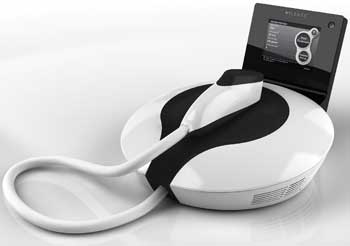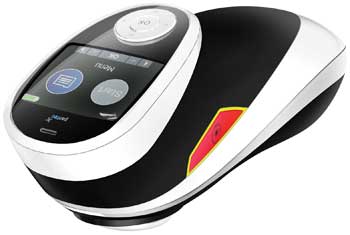When is a medical device a useful piece of equipment, and when is it an art form, pleasing to the eye and to the touch? If made with a careful eye to the needs of clinicians and patients alike, it can be both.
Innovative device design can be an individualistic or a collaborative effort, but it starts the same way each time: identifying a medical need for a new diagnostic or therapeutic approach to disease. All medical devices – but laser-based instruments in particular – are designed and manufactured with a very specific purpose in mind. From the point of view of the clinician, physician or other end user, that purpose may be chiefly identified by the wavelength of the laser, which is generally carefully chosen for its specific effect on a small range of human tissues. One set of wavelengths may work efficaciously at whitening teeth, while another may be directed at activating tumor-fighting drugs in the bloodstream.
An innovator can be born inside an academic lab, where a researcher may toil for decades teasing out the secrets of a particular molecular reaction inside skin cells, for example. On the other hand, the work could take place at a large, established company looking to fill gaps between existing product offerings.
Once the mechanics are locked in, the work isn’t finished. To attract the attention of end users, the actual utility of a device is not the only aspect in play. The form factor also carries a lot of weight: Is it compact enough to fit on a wheeled cart, or is it a bulky stand-alone instrument? Is it easy to manipulate, and does it have an easy-to-use software interface that doesn’t require a lot of training? Does it have a pleasing color scheme that both encourages and guides its use?
Ultimately, a practical device provides a medical benefit in a way that encourages doctor and patient compliance. It should be ergonomic – that is, easy to handle and manipulate by either a trained professional or by an inexperienced patient, depending on the targeted end user. The design also should consider other human factors, such as size and weight (Can it be brought to the patient, or must the patient be brought to it?).
Once a medical need or other market niche is identified, the actual design process for a new device can be daunting. It typically starts with pure thinking: Brainstorming – either by a solitary experienced designer or by a team – often helps get initial ideas about optimal design requirements down on paper. These starting thoughts can be discussed ad infinitum but eventually result in a preliminary series of illustrations; at first, sketches are drawn, and then more elaborate blueprints are developed. Semifunctional or functional models come next, and these provide direct confirmation of whether the functionality and aesthetics of the machine are in accord with each other.
The modeling process traditionally is very laborious, requiring many weeks or even months of meticulous work. Three-dimensional CAD (computer-aided design) software helps with the visualization process, but modeling still prevails. Increasingly, however, 3-D printing (aka additive manufacturing) is used to create models rapidly. In this process, a 3-D image formed by a CAD program is rendered into virtual slices, similar to the way CT segments a body image. A liquid or powder resin (or other polymer) then is deposited layer by layer, matching the shapes of each of these slices. As the layers accumulate, a high-power laser binds them together. This process contrasts with subtractive ones in which a bulk material – sheet metal, for example – is cut, punched and drilled to get to the final product.
3-D printing technologies have enabled a new field called rapid prototyping, which is important for designers of truly novel devices. The overall cost of medical instrumentation can be vastly reduced through the ability to generate a functional model within hours instead of weeks or even months. And if multiple models are needed to straighten out kinks, the time saved becomes enormous.

The P.L.E.A.S.E. Professional by Pantec Biosolutions has an award-winning design resulting from its elegance and high usability. Images courtesy of Pantec.
But how do these concepts work out in the real world? In 2010, the Red Dot Institute recognized the efforts of Pantec Biosolutions AG of Ruggell, Liechtenstein, and WildDesign GmbH & Co. KG of Gelsenkirchen, Germany, with the design of Pantec’s P.L.E.A.S.E. Professional system. The prestigious Red Dot Award was given to honor the instrument’s “aesthetically designed handpiece and base station [that] create a strong yet expressive appearance.”
The following is a discussion with Stefan Summer, Pantec’s international product manager, who describes the elements of the system’s design.
Q. What are the basic elements of device design with regard to laser-based instruments?
A. Due to the wide application range of our product, P.L.E.A.S.E. Professional, we consider safety, reliability and size as [the] fundamental elements.
Q. If there are conflicts between design elements, such as size and safety, how are they overcome?
A. Conflicting elements are a common issue, especially during the design phase. Very often, it is usability issues that interfere with regulatory requirements or the like. Ignoring them will most likely impair the product’s success, either by reducing market acceptance or by failing to obtain market approval. Compromises have to be found to overcome such situations, not uncommonly at the expense of usability.
Q. How does the concept of “filling an unmet need” affect instrument design? At what point does considering laser parameters come into play?
A. Right from the beginning, potential markets and their unmet needs have to be identified. Only then can the requirements be gathered, analyzed and prioritized to develop a tailored solution for the desired purpose. Then, using a functional prototype, the laser parameters have to be determined by conducting first field tests in collaboration with selected key opinion leaders. Following this, device development is started according to a defined development work flow, resulting in prototype devices for further tests.
Q. How are unmet needs identified – aren’t new market niches getting harder to find? Who participates in this process?
A. Closely observing existing markets and listening to customers are key to identifying unmet needs. Often they are not aware of their own needs but are resigned to the current situation. By showing them the advances in medicine and technology, new market niches are opened up that would not have existed otherwise.

The smooth form factor will make the handheld P.L.E.A.S.E. Private easy to use by nonclinicians.
Q. When are patient and clinician needs considered during the design phase? What happens if there are conflicts?
A. As stated above, clinicians and patients are already involved at a very early stage, ensuring that their needs are considered. By using the first prototypes, follow-up tests are conducted to verify the requirements. These tests often reveal open issues and improvement possibilities which can then be implemented before entering the market.
Q. Which US medical device regulations have the most effect on laser-based device design? Can you describe a case where regulations stifled a good design?
A. Laser safety regulations in general are a huge topic to consider when developing a laser-based device. Especially with non-Gaussian laser beams, the mandatory calculations cannot depict the actual situation but force developers to put much more effort into safety and interlock systems.
Q. What are the chief challenges in designing the lasers that you use? Do you design and build your own, or are they outsourced?
A. The lasers are designed and built in-house. The reason is quite simple: We have not found any lasers available on the market meeting our demands for robustness, reliability, maintenance and price. The design criteria are identical, with the major challenge being the wavelength; respectively, the laser material itself. The entire laser has been developed by taking the special properties of the laser material into consideration, leading to our novel P.L.E.A.S.E. platform.
Q. How does your device provide an example of good design?
A. Based on the first monolithic diode-pumped Er:YAG laser, this patented technology has major advantages over existing flashlamp-pumped lasers, such as a wide range of adjustable laser parameters like pulse energy, pulse duration and repetition rate. Furthermore, the laser can work 24/7 for thousands of hours. It is small, light and cost-efficient – the basic needs of medical doctors.
The first device incorporating this novel technology is the P.L.E.A.S.E. Professional, a tabletop device used for the microporation of biological tissue in conventional … as well as aesthetic dermatology markets. Next in line will be a handheld device featuring the same technology, aimed at the home-use customer.